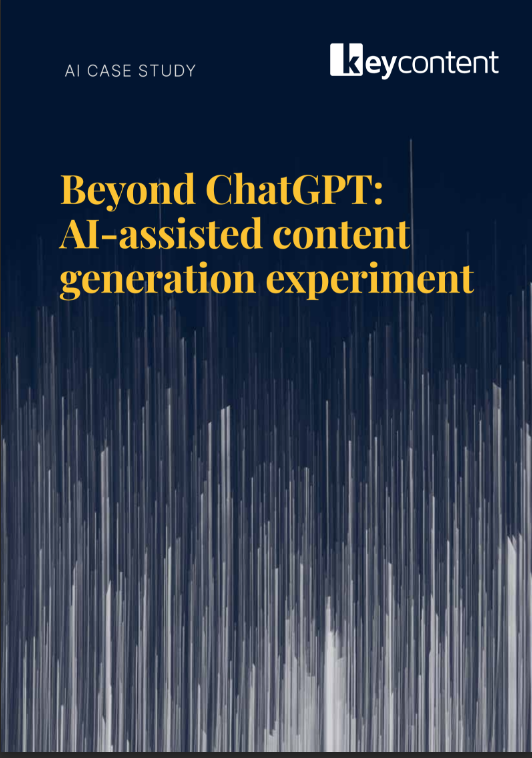AI-generated content is essentially what it says on the tin. It is content created by a computer, using machine learning combined with varied levels of human input. AI content generation plus human post-editing can be a very effective way of quickly producing quality content with expert polishing, on a large scale.
On the other hand, we have the only kind of content generation we’ve ever known until now: human writing. While it may be seductive to believe that we can hand over all content production to AI on the promise of savings in time, costs and resources, these AI tools are not yet capable of producing the kind of empathetic content that truly engages people’s feelings and experiences, and satisfies our deep-seated need for human connection.
So how do you know which AI to use, and when? Let’s examine both to help you choose an approach that will be most effective for your business.
What is AI content editing?
In its simplest form, AI content generation is a method of “writing” content automatically, using a computer to follow human “prompts”. This is an iterative process where further prompts are used to continually refine the content into a satisfactory final draft.
AI content generation plus post-editing is a hybrid approach that goes a step further by placing greater emphasis on the human element to enrich the text, making it more engaging for readers. It goes a long way to converting AI generated content to human written content. This can produce premium, authoritative copy with an expert human touch.
How to detect AI content
It’s not that hard to detect AI content created without human editing. Typically, it will merely provide information, without creating a conversational connection with the reader. You’ll often find that the content lacks flow and coherence, coming across as somewhat stilted and superficial. This severely compromises readability.
Additionally, and despite all their power, AI tools still produce awkward semantic phrases and even grammatical errors. More worryingly, they’re also prone to factual errors.
How to humanise AI-generated content
Besides fixing obvious errors, post-editing is an effective way of humanising AI-generated content, enhancing readability and improving user experience.
Even with the most refined prompting, an AI tool will still struggle to exactly replicate your established brand tone and style. In particular, it can make your brand seem a bit aloof. Human post-editing will infuse the content with more empathetic human engagement qualities.
Humanising AI-generated content also involves adding nuances that reflect current social sensibilities and are in touch with people’s circumstances on the ground, their feelings about a topic and their historical experiences.
Human content writing vs AI content generation plus post-editing
Human content writing still wins first prize when creating premium, engaging copy that connects with all the various aspects of human experience to convert your target audience to your brand. At Key Content, we highly recommend this type of high-quality editorial content for customers aiming to captivate both search engines and human readers alike.
However, you don’t always need it. AI content generation plus post-editing can perfectly suit your purposes for other types of online publishing, such as blogs that aim to drive traffic

When to use each option
Here are some things to bear in mind when deciding whether to use human writing or hand the task over to an AI tool with human post-editing.
Human writing
There’s no denying that expert human writing can be costly. While it’s always well worth the price, both in your bottom line and in terms of search engine success, with the advent of AI tools, you can employ it more tactically and cost effectively.
Reserve this kind of writing for the most important content that conveys your brand tone and values, such as your core website copy. The aim of this copy is typically to lead visitors through your conversion funnel and convert them according to your business strategy, be that accumulating leads, gaining newsletter sign-ups or direct e-commerce sales. This type of persuasive content needs to be carefully crafted to engage with visitors on a human level and create a strong brand connection to move them through each step of the user journey.
AI-generated content plus post editing
Use this type of content generation to save time, money and human resources when creating informative long-form articles, where an AI tool can do the research and create a first draft. Thought leadership articles and opinion pieces are good examples.
Content like this doesn’t aim to persuade or convert; it is designed to establish authority and expertise in your industry. AI-generation plus post-editing can produce this form of content exponentially faster than a human writer researching from scratch and writing the first version.
These are only two ideas, but you can use them as a general rule of thumb. When you want empathetic, engaging, persuasive content aimed at conversion, use a human writer. If you’re aiming for authority and industry expertise, AI content generation with post-editing can be more productive and cost effective.
Evaluating their pros and cons
Naturally, there are advantages and disadvantages to both forms of content generation:
Human writing pros:
- Creates human engagement and connection.
- Understands and uses human nuances that AI isn’t aware of.
- Shows real-world expertise.
- Engenders personal trust in your brand.
Human writing cons:
- Can be more expensive.
- Takes longer than AI content generation.
- Expert resources are often scarce.
Pros of AI content generation plus post editing:
- Huge time savings.
- Potentially more cost efficient.
- Can produce much more content faster.
- Has excellent scalability.
Cons of AI content generation plus post-editing:
- Doesn’t completely adopt on the tone and style of your brand.
- Cannot connect with human feelings through empathy in the copy.
- Lacks the nuances of human experience and memory.
- Can require more fact-checking than expected.
Will AI replace content writers?
Anyone who claims to know the answer to that question in this early stage of AI-generated content is probably foolhardy, but we can at least extrapolate a little from the current situation to a near-case scenario.
First off, AI-generated content is not going away. Once technology is released and publicly adopted, it’s nigh impossible to retract. It’s inescapable that we will increasingly adopt AI tools.
All current indications are that the most likely way we will use AI content tools in the short- to medium-term is in combination with human input. This varies along a spectrum from simple prompting to post editing of AI content, AI partnership writing and pure human writing.
Given this scenario, it’s unlikely that AI will replace content writers overnight. It still requires substantial human input and even the most basic AI tools can’t function without prompting.
Furthermore, the glossy surface of AI-generated content masks the fact that everything these tools currently produce relies on existing information created by humans (read: the Internet). It also obscures the high levels of human quality control required to ensure AI content veracity and prevent misinformation or worse.
These tools also have some way to go when it comes to replicating all the human qualities and imagination required for truly engaging and persuasive writing.
Key Content’s takeaway
Equip yourself with a balanced mix of AI content-generation tools and expert human writers, and use each judiciously according to your requirements. Closely examine all the different types of content you create and allocate human and AI combinations in the right proportions according to what each piece of content aims to achieve. The guidelines above will help you in this.
This doesn’t mean investing in all these resources yourself or distracting from your core business. You can outsource everything to a proven and trustworthy expert content creation agency like us. At Key Content, we excel in crafting a content strategy that optimises your resources, leveraging the strengths of both human expertise and AI capabilities. Get in touch with us today to unlock the full potential of your content.

[1] Source: https://blog.hubspot.com/marketing/ai-detection
[2] Sources: https://www.tomedes.com/translator-hub/how-to-post-edit-ai-generated-content, https://proofed.co.uk/knowledge-hub/6-tips-for-editing-ai-generated-content/
[3] Source: https://www.news24.com/news24/tech-and-trends/news/the-unseen-human-workforce-behind-ai-including-chatgpt-20230523



